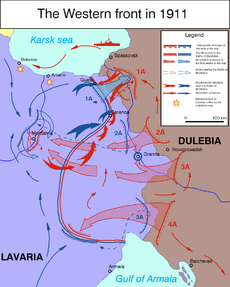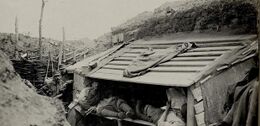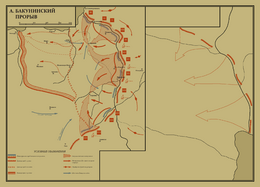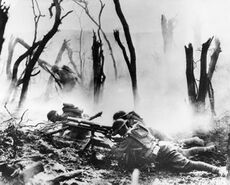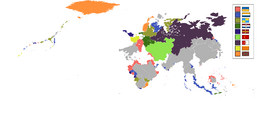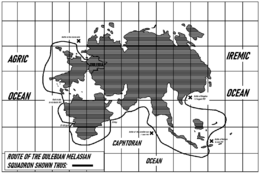Great War (Aurorum)
This article is incomplete because it is pending further input from participants, or it is a work-in-progress by one author. Please comment on this article's talk page to share your input, comments and questions. Note: To contribute to this article, you may need to seek help from the author(s) of this page. |
| Great War | |||||||
|---|---|---|---|---|---|---|---|
Clockwise from the top: Mascyllary soldiers advancing with a Kettenkampfpanzer III.a at the Battle of the Rohrn; Lavish infantry in the trenches of Balchevsk during Operation Pincer; Dulebian soldiers entering the city of Mirkowice in 1914; Cuthish troops wearing gas masks and firing a Brodley machine gun during the Second Battle of Augusthal; Ships of the Mascyllary Eastern Fleet; The shelled landscape of the woodlands surrounding Baranca on the Western Front in 1913 | |||||||
| |||||||
| Belligerents | |||||||
Armala Coalition
|
Central Alliance | ||||||
| Commanders and leaders | |||||||
|
|
| ||||||
| Strength | |||||||
|
Total: 12,452,106 |
Total: 10,023,000 | ||||||
| Casualties and losses | |||||||
|
Military dead: 1,774,976 Military deaths by country |
Military dead: 1,736,852 Military deaths by country | ||||||
The Great War, also known as the Great Berean War or the World War, was a significant global conflict primarily between nations in Siantria and Telmeria in Berea and overseas in Caphtora, Pamira and Alvinia, that lasted from 1911 to 1916. Having reached a never before seen scale, it led to the mobilisation of more than 20 million military personnel, making it one of the largest wars ever fought. With an estimated three million combatants and one million civilian deaths as a direct consequence of the war, it is also one of the deadliest conflicts in history. The conflict began on September 7, 1911 following X. It lasted until the unilateral surrender of remaining Central Alliance powers on May 29, 1916 and peace was declared following the Treaty of Lehpold in early 1917.
-How countries declared war on each other-
Both members of the Central Alliance were forced to fight on two fronts following the start of the War. The Dulebian plan was to knock Lavaria out of the war in several weeks with a rapid advance towards its capital Aniarro, and later aiding Cuthland against Valimia and, potentially, Mascylla, to the north. Dulebia was the country to start the armed hostilities during the war with the naval bombardment of the Lavish Karsk Sea coast conducted between 8 and 10 September 1911, followed by a massive advance of troops across the whole border, an operation later becoming known as Operation Rassvet or Plan 20. The Lavo-Fallish Agreement of 1865 dragged Falland into the conflict, with it declaring war on Dulebia and later Cuthland; Mascylla responded to a Cuthish declaration of war with military action against it and Dulebia on 13 September. In Rovina, the declaration of war between the Central Alliance and Valimia resulted in offensive operations conducted by Dulebia in the opening weeks of the conflict in order to prevent possible encirclements of Cuthish forces fighting to the south of Lake Sigismund. With the outbreak of the war, several attacks on Cuthish colonies in Caphtora and Pamira and Dulebian possessions in Melasia was initiated by the Armala Coalition, ultimately resulting in the capture of most overseas territories of the Central Alliance by the end of the year. The Battle of the Karsk Sea Gate, fought only several months after the beginning of the war, became the first major naval engagement in the conflict.
By 1912, the Central Alliance could no longer rely on supplies from its colonies. The Dulebian offensive in Lavaria was halted after the Battle of Montalvia, with the front stalling into a war of attrition, requiring more material and manpower from both sides. Similar fate was faced by Mascyllary and Cuthish troops on the Northern Front after the Battle of Lückwalde and Second Battle of Lensrau, as well as Duleabians and Valimians in the Riliva Mountains. All sides faced heavy casualties from the new weapons utilized on the frontlines, resulting in the first anti-war protests across Berean countries.
Kenlong joined the war on the side of the Central Alliance while Fen Yudong joined the Armala Coalition in the second half of 1912, spreading the war to southeastern Pamira. In Berea, the Gurkhan Empire declared war on Dulebia, opening a third front in the south of the country and threatening to take all of Pomoria. The momentum was used by other Armala Coalition members, with the most notable examples being the unsuccessful 1913 Balchevsk Landings conducted by Lavaria and the Mascyllary Pentecost Offensive.
Dulebia conducted an attempt to break the stalemate in the war in late 1913: under a new leadership, the country defeated and effectively knocked out the Gurkhan Empire out of the war, and initiated the Bakunin's Breakthrough, which, while failing at knocking Lavaria completely out of the war, ceased all actions on the Western Front for the rest of the year. The combined Dulebian and Cuthish forces rapidly advanced into Valimia, threatening to force it to capitulation, leaving Mascylla alone in continental Berea. The several major offensives of Dulebia in 1913 led to the biggest amount of casualties any combatant would see, and resulted in rising public unrest, culminating with the Dulebian Revolution and civil war in 1914. The country was forced to sign ceasefire treaties with Lavaria and Falland, becoming the first Berean great power to be completely knocked out of the conflict, and fell in a state of civil war for the following five years, ultimately becoming the first communist state in Berea. Left without its most important ally, Cuthland was forced to fight on several fronts, and eventually collapsed after two more years of fighting on its own territory and during the Battle of Alderport, in 1916. Its capitulation resulted in the end of the Great War.
The Great War at large was a political, economic, cultural, and social turning point for the world. It is generally considered to mark the start of the collapse of Berean imperialism, and saw the dissolution of multiple influential states and the deterioration of others' powers. The war and its immediate aftermath saw a number of revolutions and uprisings in Dulebia, Cuthland, Mascylla, Valimia, and Sarrac. Through the political instability, the Big Three (Falland, Lavaria and Mascylla; the principal Armala Coalition members and war victors) emerged their power as great powers and imposed their demands on the defeated enemies in a treaty drafted and signed in 1917—the Treaty of Lehpold.
Ultimately, the intergovernmental organisation of the Assembly of Nations was founded to spearhead international cooperation and to prevent another large-scale conflict. The end of the war saw the establishment of an unipolar order in Berea, with the defeated Central Alliance members becoming isolated from the international community for the next decade. The tension and unresoved disputes after the war would ultimately result in a number of crises and armed conflicts, culminating with the Great Game.
Background
| Events leading to the Great War | ||||||||||||||||||||||||
|---|---|---|---|---|---|---|---|---|---|---|---|---|---|---|---|---|---|---|---|---|---|---|---|---|
 | ||||||||||||||||||||||||
|
||||||||||||||||||||||||
Political atmosphere and ambitions
Dulebian and Cuthish partition of Rovina
Cutho-Mascyllary rivalry
Dulebo-Lavish rivalry
Colonial ambitions of Dulebia and Cuthland
Arms race
Tensions in Berea
Prelude
The war
Western Front
Dulebian offensive and entrenchment
The armed conflict in the west between the Dulebian and Lavish armies began on 25 September 1911, 15 days after the declared full mobilization of Dulebian forces. According to the Dulebian pre-war plan, Operation XX, more commonly known as Operation Rassvet, the Dulebian army was almost entirely stationed on the Lavish border, with the bulk of the forces situated to the south on the Volynsk Plain. The Dulebian command left its northern flank relatively weakened, and planned to use the River Lena as a natural barrier and defence frontier. This positioning of the Dulebian forces was used to lure the Lavish forces to attack on that part of the front, leaving the south mostly undefended against the main Dulebian advance.
The Dulebian right flang was ordered to retreat towards Lena on 26-28 September, this retreat was followed by a Lavish attack, as planned by the Dulebians. Then, on 29 September, the Dulebian offensive was launched on the left flank by the 2nd Field Army of General Kuznetsov and 3rd Field Army of General Bakunin. The two armies met severe Lavish resistance on the river Lena, where the Lavish constructed a fort near the town of Guiangarado. The Siege of Guiangarado was the first major battle of the campaign, and slowed the Dulebian advance by two days, giving time for Lavish command to form new army in the south and march it to the Dulebian border. Simultaniously with the armies of Kuznetsov and Bakunin, 4th Field Army under Birulyov, originally kept as reserve to protect the southern frontiers of Dulebia against possible intervention from the Gurkhan Empire, was ordered to cross the Lavish border and attack the Lavish reinforcements marching from the south, protecting the left flank of 2nd and 3rd armies. The advance of Bakunin and Kuznetsov was halted near the city of Montalvia; the Dulebian forces, who managed to march almost 120 km into Lavaria in less than a week, overstretched their supply lines and the soldiers were exhausted from the rapid advance. The communication lines of the Dulebian forces have not been established. However, the Lavish forces already started to regroup and a significant portion of their armies were stationed near Montalvia. Facing the risk to lose momentum, Bakunin ordered his forces to cross river Montalvia and mit the Lavish head-on without reinforcements or an established supply chain. In the resulting Battle of Montalvia, Dulebia faced the first major defeat in the campaign, and its advance was stalled.
Following the Dulebian defeat at Montalvia, the Gurkhan Empire, which remained neutral since the start of the war, declared war on Dulebia and invaded the Muromo-Pomorsk Kingdom on 4 March, meeting almost no resistance as all Dulebian forces were sent to the Western front. These events forced the Dulebian command to stop all advances and initiate a regrouping of its forces. General Milyukov, commander of the 1st Army on the Dulebian right flank, who sat in defence behind Lena since the start of the campaign, was ordered to attack and push towards Aniarro as it was believed the Lavish presense there was limited after the regrouping of Lavish forces near Montalvia. At the same time, 2nd Army of Kuznetsov, which already managed to establish stable supply chain, received orders to turn north and connect with Milyukov, attempting encirclement of the Lavish forces between Bakunin's 3rd Army and the Karsk Sea coast. Lavish forces attempted a similar maneuver to encircle the advancing forces of Milyukov. As both forces raced towards the Karsk Sea, they had to leave significant amount of forces on the newly-forming frontlines in order to protect their flanks from possible encirclement attempts by their opponent. As a result of this operation, the frontline was stretched even further and in the end it was stalled; both Lavaria and Dulebia found themselves in a stalemate and began entrenching to preserve their current positions.
Winter Offensive of 1912 and the frontline stall
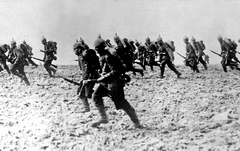
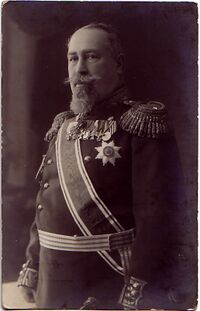
The Dulebian forces were very disorganised after the defeat at Montalvia and the following race to the sea, and suffered from very low morale due to the heavy casualties of the first weeks of the conflict. The early advances in Lavaria led to the destruction of the rail and road network, leading to serious problems with supply on the Dulebian side. Besides that, the Lavish forces, which experienced even heavier casualties, managed to finish their mobilization in early December, and planned a winter counter-offensive in January on the northern section of the front, where the Dulebian defence seemed the weakest. Lavish concentrated a vast force of almost one million men on the Aniarro-Montalvia section on the front, and launched an offensive on 31 January 1912. Dulebian High Command, due to its inability to request troops from the Southern Front, was forced to call for a retreat back to the Dulebian border and further inland to the river Lena, as was initially planned in case of a failure in the beginning of the war. During their retreat, Dulebian forces deployed scorched earth tactics and completely destroyed the infrastructure of the Guefa region. Regardless of their enemies' retreat, Lavish forces met heavy resistance during their advance, and lost almost half of the initial force upon reaching the river Lena. They were forced to stop at Lena, since they didn't have the manpower to cross the river and meet the heavy pre-war defence line of the Dulebian empire on the right bank. At the same time, Lavish attempts to also destroy the Dulebian forces on the southern section of the front ended as complete disaster. As a result of the Winter Offensive, Lavaria lost 650,000 men dead, wounded or missing. The deployment of scorched earth tactics by the Dulebians left most of of the frontline completely worthless, hard to defend, and forced Lavaria to waste a vast amount of resources to repair the destroyed infrastructure. All these factors initially made it hard for Lavaria to perfom fast relocations of troops as it could in 1911. The frontline stalled after the Winter Offensive for the next year.
Both sides needed several months to recover from the Winter Offensive. Between March and December 1912, Dulebian forces under Bakunin attempted to cross Lena three times, but all resulted in a bloody failure. These crossings are now known as the Three Battles of Ust-Borovsk. Identical attempts of Lavish forces on the southern section of the front, namely the Armala Offensive of July-October 1912 resulted in similar failures, with the Lavish managing to gain only a small portion of land on the Armala Gulf coast of little strategic value, at the expense of 50,000 dead Lavish. The prolongued trench warfare of 1912 and the resulting stalemate of the Western front in that period, however, had a serious effect on the living conditions of the soldiers in both armies. Diseases like flu, trench fever, on par with numerous parasytes like body lice, psychological traumas and disorders like shell shock, and traumas caused by the armed action itself, especially by chemical weapons like chlorine and mustard gas both significally lowered the troop morale and caused thousands of casualties even outside of combat. The low morale in the Dulebian army eventually led to the spread of various radical political ideas and unrest among the troops and their families at home. Undercover political powers, most notably the far-left communists of Viktor Shchyukin, used the situation to agitate against the war and for a revolution among the frontline troops. As the war progressed, these ideas became more and more popular on the Western front, where the Dulebian Empire was the least successful during the conflict. This eventually led to the Dulebian Revolution in 1914.
Bakunin's Offensive and the Dulebian Revolution
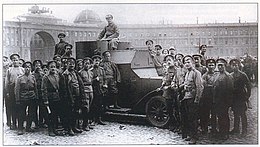
The front stalemate continued into 1913, with both sides failing to win decisively. By February 1913 Mikhail Bakunin, the commander of the Dulebian 4th Army, proposed a shock attack on the whole length of the front with the usage of brand new tactics for the era. Bakunin was promoted to Field Marshal and commander of the whole Western Front in March 1913, his plan was accepted by the emperor himself, and mass mobilization in preparation for the operation commenced in mid-March. The mobilization was finished on the 15th of May, 1913. Almost 5.3 million men were mobilized, which was equal to 21% of the Dulebian pre-war population. 3 million men were stationed on the Western front on two sections, with the majority of the manpower focused in the north behind the river Lena, where the frontline stood since 1912. The operation was planned to be launched in August 1913, however, due to several defeats of the Cuthish forces against Mascylla and the information about three Lavish armies being transported to aid Mascylla on the Northern front, Bakunin was forced to launch the offensive on 26 May, 1913.
Dulebian divisions crossed the Lena in the morning of 26 May, and managed to inflitrate the Lavish trenches on the left bank of the river in several points of the front, most notably at Ivanovo and Ust-Borovsk. Dulebian forces failed to cross Lena in several places, where the Dulebian casualties reached 5,000 in the first day of the operation. Nevertheless, until 31 of May, Bakunin had a stable lodgements in three sectors of the front, from which the Dulebian forces continued their advance. The key cities of Bravara and Baranca were reached and captured already before 10 June, and the rapid advance continued throughout June. Dulebian forces were forced to stop only at Aniarro, the capital of Lavaria, on 31 June. In the same time, at the southern front the Armala Offensive was launched almost immediately after the Bakunin Offensive, with the key objective of reaching Armala, key port of the Lavish navy. Dulebian forces on this part of the front were commanded by General Kirilov, who was not as experienced in maneuver warfare. As a result, Dulebia had only minor success in the Armala Offensive, only breaking 100-150 km into Lavish positions, while facing almost the same amount of casualties as the sector under Bakunin.
Bakunin's offensive is seen as the peak of Dulebian effort in the Great War, and is often named as the breaking point in the war for the country. On one side, the huge success of the operation can be explained by the outstandingg tactics proposed and executed by Bakunin: Dulebian forces relied on short, accurate artillery barrages, rapid advances of small specialist groups followed by the main forces, a tactic later known as "infiltration". Armoured vehicles like armoured cars, light and mobile artillery pieces, the extensive use of early improvised self-propelled guns, and the first active usage of air support in the war, and the attempt to use highly-motorized supply vehicles, all are seen as major contributors in the Dulebian victory on tactical level and would later become the basis for the Dulebian shock and infiltration tactics of the mid-20th century. Bakunin himself would become a renowned supporter of the idea of modern warfare and a pioneer of the usage of tanks in the Dulebian People's Army after the Dulebian Civil War. On the other side of the coin, however, are the casualties suffered by Dulebia, which were the highest since the beginning of the war, reaching 450,000 dead, wounded or missing by July 1913. En par with previous low morale of the Dulebian forces, the heavy casualties in the operation and the limited success of the Armala Offensive, led to first riots in the troops. To worsen the situation, in September 1913 Bakunin and most of the veterans of the operation were transferred to the Valimian border in preparation for Operation Luch, while the Western front was given to Field Marshal Ilya Shchors, the old commander of the Army Group North who showed little-to-no success against Valimia ever since the start of the war, and is generally described as a poor commander who refused to implement the new technologies introduced during the conflict, relying on outdated cavalry attacks and mass infantry doctrine. The breaking point was the defeat of Dulebia in the Battle of Aniarro, where the forces of Shchors failed to cross the river X, and suffered from heavy casualties, the heaviest inflicted to Dulebia in a single battle since the beginning of the war. This led to the outbreak of the Dulebian Revolution in February 1914 in Ulich and Kamianets. The royal family was arrested by the revolutionaries on 13 February, and the Dulebian Civil War begun the same month between royalists and radical communist revolutionaries under Shchyukin. In these conditions, the Western front collapsed in February, a situation used by Lavaria to start a massive offensive, which saw very limited resistance from Dulebians. Lavish crossed Lena by March 1914, and even besieged Spassovsk and Novocherepovets. The Dulebian Communist Party under Shchyukin, which needed to focus all of its forces in the civil war, asked for peace.
Following the Ulich Peace Treaty of 1914, Dulebia gave up all of the territory captured since 1911, the city of Bravana, captured by Dulebians in 1870, and most of its territories on the Endotheric Sea, most notably the Muromo-Pomorsk Kingdom. The defeat of Dulebia and the collapse of the Western front left Cuthland as the last major combatant in Berea. The fall of Dulebia led to the collapse of the Cuthish effort in less than a year; the war ended in 1916.
Eastern Theatre
Cuthish front and advances
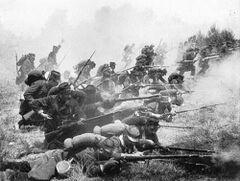

The outbreak of the war was quickly followed by the rapid forward deployment of Cuthish army forces, a total of X field armies under the command of X, along the entire length of the boundary to Mascylla in Asary, Dorsace and Elpsland on September 19; this was among the first military action taken in the Great War. The first cities being attacked and quickly taken were Bad Ülerst and Saarow, whose garrisons retreated to the heavy fortifications protecting Wärthberg on the river Mogd. The initial delay through disturbed telegraph communication lines meant that the deployed eleven field armies of the Mascyllary Kingdoms in the west were hastily mustered without much tactical decisionmaking or premeditation. Therefore, the Cuthish advance through the Gasselian Mountains easily broke through the first defences, encircled Wärthberg and the Third Army on October 1, and mounted a quick sweep into the Fanian Plain. Within the first two months, the Cuthish X was successfully establishing a siege around Augusthal, the capital city of the Kingdom of Aldia, on October 19. The subsequent First Battle of Augusthal lasted until 27 February 1911 and proved to be a desastrous loss for the Mascyllary, having suffered obliterating materiel and human losses, and being forced to retreat to Weidenau in March and Lensrau in June of the same year; a chaotic retreat towards the River Blaugold was the result, punctuated by engagements such as the Battle of Hubertsburg, Siege of Merzenich and Battle of Winden in early spring.
Until late 1911, Cuthland militarily seized about 28% of Mascyllary territory with various centers of industry and manufacturing contained within it and controlled more than half of pig iron and steel production sites as well as a quarter of Mascylla's output in coal mining. The inflicted losses exacted a traumatic toll on Mascyllary morale and resources, and the Reichsrat officially proposed seeking a peace truce to then-Prime Minister Hermann von Martinsen and King Ludwig I on July 8, 1911. By that time, the Cuthish X Army under X attacked Reifurt, some 63 km (39 mi) away from Königsreh itself. However, the subsequent Battle of Lückwalde on July 10 proved to be a decisive victory for the Mascyllary Eleventh Army under Generalfeldmarschall Erhardt von Belau, utilizing an exploitative gap in Cuthish forward positions, undertaking a daring outflanking maneuver with an Adwhinish cavalry charge under Prince Georg of Adwhin, and driving the Cuthish back to Lensrau within two days, therefore ending the continuous advance into Mascylla. The Cuthish X Army first established entrenchments on the River Lahr on August 2, and precipitated the solidifation of the frontier from repeatedly-shelled Pereuth on the North Sea to Lake Sigismund in the south, despite strenuous efforts by either side to lift the wrongly presumed temporary stalemate. To counter this, the X Army tried to break defences directly outside Lilienburg in Gothia in late September of 1911 in order to open a second Mascyllary front, but proved to be vastly ineffective in light of the developing front in Valimian Rovina by 1912.
Trench warfare and progress of the war in Mascylla
Valimian front
Before the outbreak of the war, Valimia was not considered a significant threat by both Dulebian and Cuthish military commanders. Valimia was lacking severely behind the Berean powers in terms of equipment, discipline and infrastructure. It was expected that the mobilization of the country would take up to two months, time sufficient enough to invade the important industrial region of Rovina and establishing a defensive line there. The attitude of the Dulebian military elite towards Valimia and its armed forces was clearly expressed by Yury Shtass, Field Marshal of the Dulebian Army in the outbreak of the war and the author of the Operation XX, in his dialogue with the Emperor of Cuthland in 1909:
"The question of possible Valimian involvement in the incoming war could not be less interesting for me. The Valimian army is underequipped, untrained, disorganised, and led by completely incompetent officers. If Valimians decide to join our effort, I'll need four divisions to aid them against Mascylla in Adwhin. If they decide to oppose us in the war, I'll need four divisions to push them out of Rovina."


The low opinion of the Central Powers is partially understandable: at the time, Valimia was severy lacking behind the Berean powers in terms of technology; the Valimian tactics were outdated, and the country fielded a very small fleet that couldn't counter the Cuthish White Sea fleet. Apart from that, the soldiers of the country suffered from very low morale which was even encouraged by the commanding officers after the beginning of the war: soldiers were rarely given rest between battles, and the Valimian propaganda among their own troops was practically unexistant. In these conditions, the Valimian Army showed poor results already in the 19th century during the armed conflicts with Cuthland and Dulebia in Rovina, when the country lost small portions of land to the future Central powers, most notably in the Valimo-Cuthish War of 1882.
Before the start of the war, Dulebia prepared a 5th Army under General Ilya Shchors. The army consisting of 4 divisions was split between two sections of the Valimo-Dulebian border: 2 divisions were stationed on the Vitevsk-Knyazy Stan Line, and two in the mountains around Tsaritsyn. Upon declaration of war by Valimia, the 5th Army of Shchors entered Valimia, with the first two sections ordered to capture Ritavice and stop at the river XX, while the other two were tasked with pushing the Valimian forces to the northern banks of the rives YY and ZZ, and capturing the strategic city of Jarowiec. The operation lasted 7 months and eventually led to only limited success: Dulebian forces reached the river XX in the west, but failed to capture Ritavice, their primary objective. The eastern section performed even poorer, barely managing to leave the Riliva Mountains only to be met by a well-prepared defensive line in southern Rovina, where it was forced to entrench and halt its advance due to severe casualties. The progress of the war on the Western and Southern fronts made it clear that Schors could receive only limited reinforcements: he was forced to halt any advances and try to hold the territory already under his control until the high command could send him reinforcements.

This situation was exploited by the Valimian forces: in March 1912, parallel with the Gurkhan invasion of Southern Dulebia, the Valimians launched the First Riliva Offensive against the two divisions in southern Rovina, with the primary objective to push the Dulebian forces in this section of the front back to the Riliva Mountains. This battle, however, proved the poor state of the Valimian army: while having more men and artillery on this section of the front (Valimians prepared almost five fully-equipped divisions against the two divisions Dulebia stationed here since the outbreak of the war), General Aksel Airo failed to penetrate even the first defensive line of the opposing forces for almost two weeks, and ultimately his forces managed to penetrate into the Dulebian lines only 2-3 km on most of the frontline's length. Valimians attempted to attack the Dulebian defenses in the region 4 times in total between 1911 and early 1913: the first two Battles of Borowice were repelled by the Dulebians, who nonetheless suffered from heavy casualties. The Third Battle of Borowice remains the bloodiest battle of the Valimian forces, where both sides lost between 50,000 and 75,000 men each, while the battle itself remained almost indecisive. The Fourth Battle of Borowice was the first major success of the Valimians on the offensive: the Dulebian defenses in South Rovina were broken, and Shchors was forced to retreat to the Riliva Mountains, where they had a decisive advantage of the hard terrain of the mountainous region.
In June-August 1913, General Akself Airo attempted to assault the Dulebian forces near Ritavice on the Western section of the front. This advance proved unsuccessful, as the Dulebians had the advantage of the river XX serving as natural barrier and a first level of their defense. Badly blooded, Valimians retreated from Ritavice; the city itself fell to the Dulebian counter-attack the same month as Airo had no troops left to defend it. When the inability of Valimia to continue the war became obvious to the Dulebian High Command, the decision was taken to start an offensive on the Valimian front. Following the grand success of Bakunin during the breakthrough on the Western front, he was transferred to Valimia together with 5 divisions of veteran troops from the Western and Southern fronts. Dulebians launched an attack from Ritavice, supported by Cuthish troops under the command of ZZ, on 5 September 1913. Valimians, unprepared for the rapid advance of Bakunin, and suffering from lack of equipment, medicaments, and reinforcements, were quickly pushed back to Mirkovice. The cities of Mirkovice, Jarowiec and Biestrzyn were occupied by December 1913.
Even the severe winter conditions in Rovina could not stop the advance of Bakunin, which continued into the first months of 1914. The collapse of Valimia was used by Cuthland to launch a strategic operation in Adhwin. Valimia was already prepared to ask for peace as the Dulebian forces were reaching the Ejeva Mountains in modern-day Valtriva, the last natural border between them and the capital of the empire in Paavalpori. However, with the outbreak of the Dulebian Civil War, Field Marshal Bakunin took the decision to stop the advance and turn his forces back to Dulebia to protect Erjarvia and join the civil war, performing the Great Bakunin's March. This decision had proven vital for the fate of the Cuthish forces on the Eastern front: as Bakunin left, both Valimia and Mascylla used the momentum to launch counter-offensive operations on the whole length of the front against the outnumbered Cuthish army. The Rovinian region itself saw increased civil unrest as Rovinians tried to gain independence from both Dulebian and, later on, Valimian rule, which was largely ignored by the Dulebians in 1914 due to their own civil war, but was repelled by the Valimians in 1915-1916.
Southern Front
Early Gurkhan advances

At the outbreak of the war, the Gurkhan Empire suffered from a political crisis: the Gurkhan, Selim IV, was in favour of joining the Allied forces and attacking Dulebian possessions in Pomoria, taken from the Gurkhans following the Dulebo-Gurkhan War of 1899-1902. In the same time, the Grand Vizier Mehmed Sadık Pasha was in favour of the Central powers. The strategic position of the Gurkhan Empire threatened the communications of Lavaria and Mascylla with their colonies in Eastern Pamira. The Gurkhans possessed a strong navy in the Endotheric Sea, which could aid the Dulebians if the country was to ally with them. Such a strategic position led to the struugle of both blocs to ensure the support of the Gurkhans. In the first week of April, the Grand Vizier died mysteriously after an audience with Lavish diplomats in Hasenta. In the following two weeks, the Gurkhan Empire began mobilising troops on the Dulebian border, and on 29 April it ceased all diplomatic relations with the Dulebians. On 4 March, 1911, the Gurkhanate declared war on Dulebia, and its armies marched into the Muromo-Pomorsk Kingdom. This maneuver was undertaken by Selim IV to aid the Lavish forces on the Western front. As historians suggest, Selim was most probably promised the majority of Pomorian lands in exchange of an immediate attack against Dulebia.


The Gurkhan forces suffered from lack of equipment and low morale, but still managed to score several important victories against the Dulebian force which was very limited in size; the majority of the Dulebian manpower was located on the Western and Valimian fronts, the Gurkhans were not treated as threat by the Dulebians. The Gurkhan forces captured the city of Bakhchi-Sarai on 16 March, and reached the Haydushki Mountains on 17 March. The Dulebian 4th Army under Birulyov was ordered to dispatch half of its strength into a new 5th Army under General Kruzenshtern. Kruzenshtern was ordered to march south to stop the Gurkhan advance and protect the port of Balchevsk. In the same time, the Gurkhan advance on the Tayari front reached past the Verkhoyansk Plateau: the forces of General Suleiman Pasha reached Ekaterinoslavl: one of the biggest Dulebian cities and a major causeway in the Dulebian south. The small garrison of the city, composed of 5,500 soldiers, 1,200 policemen, and several thousand volunteer militia, met the force of 22,000 Gurkhan soldiers. The city was besieged, but ultimately the Gurkhans failed to completely cut it off the supplies from the north; furthermore, Gurkhan attempts to enter the city on 28-31 March ended as crushing defeat, the Gurkhan forces lost almost one third of their forces. Gurkhans were forced to retreat from the city in the first week of April after the defeat of the 1st Army near Balchevsk: fearing a possible surrounding, the Gurkhans in the Haydushki Mountains withdrew from the city of Ekaterinoslavl.
Kruzenshtern used the retreat of the Gurkhans to regroup and prepare a counter-offensive on his own. In the first hours of May 1911, Dulebian troops attacked Gurkhan defense positions in the Verkhoyansk Plateau and marched inland into the Gurkhanate, threatening the city of Șaparkorum, a major port of the empire. The advance of Kruzenshtern, known as the Haydut offensive, proved to be a grand success: Gurkhan forces were pushed almost 180 km inland. The advance of the Dulebian forces was supported by various Pomorian armed militias; some of them conducted partisan warfare against the Gurkhanate armies. The forces of Suleiman Pasha responded with a number of repressions in villages and towns in the region between May and July, until when they were pushed out of Pomoria. The result of these war crimes was the further consolidation of locals against the Sultan and his rule.
Landings at Balchevsk
Collapse of the Gurkhan empire
Other fronts

Melasia
Prior to the outbreak of the war, most of the Melasian and Mavronesian archipelagos were under the control of Armala Coalition states, with the majority of them being part of the Federated Melasian States under the Mascyllary crown. However, three major and several smaller islands in the southern part of the region, namely the Aleksandrovsky, Takawa and Vostok Islands, were under the rule of the Dulebian colonial empire since the early 19th century. While being an underdeveloped and virtually unprotected colonial asset of the Dulebian empire, the islands could serve as a forward base for possible Dulebian merchand raiders, and the small but potent garrison of the colony posed a threat to the inner parts of the Federated Melasian States. All these circumstances led to the early attacks of the Dulebian possessions in October 1911. The island colony was invaded by several thousand Melasian units aided by a smaller number of Mascyllary colonial troops. The significantly outnumbered Dulebian forces held the major ports for only two weeks, with the last port of Takawa falling into Mascyllary hands on 28 October 1911, marking the end of the campaign in Melasia.
In desperate attempt to save their colony in Melasia, Dulebian High Command dispatched a part of the Karsk Sea Fleet while it was on its way to the Arthurean Strait to take part in the battle, a decision which, according to some historians, proved vital for the outcome of the battle. The expeditionary squadron under Admiral Glazkov refueled in the Carra Republic, and later sailed around Falland on route to Melasia. The squadron consisted of seven ships: two dreadnoughts, four destroyers, and one of the three newest battleships of the country, HDIMS Admiral Rzhanevsky. The squadron stopped for another refueling in Caphtora, and later harassed allied shipping in the Caphtoran Ocean, raiding several Lavish colonial ports and shelling the city of X in Eastern Caphtora. Unaware of the force of the squadron, Mascylla sent Admiral Alfred, Crown Prince of Welsbach, along part of the Mascyllary Melasian Squadron (Melasiengeschwader) to intercept the Dulebian ships in the Caroline Sea. In the Battle of Caroline Sea, the Dulebian squadron sunk 3 Mascyllary destroyers and one pre-dreadnought, effectively wiping out half of the Mascyllary navy in Melasia. The Dulebian squadron reached the Tarokan Sea two weeks later, only to find that the city of Vostok, the last Dulebian port in Melasia, was already partially captured by the forces of General Karl Georg von Pritnitz. The ships of Glazkov retrieved several hundred refugees and soldiers from the city, added the last remaining cruiser of Bokalov to the squadron and fled to Yudong to refuel. On their way through the Tarokan Strait, they were intercepted by the remainder of the Mascyllary Melasian Squadron under Helmuth von Kraisach, in a daring attack. Von Kraisach expected the Dulebian ships to be damaged since the engagement in the Caroline Sea and to be running low on ammunition. However, his entire fleet was sunk in the battle that lasted three hours; Dulebia lost one destroyer and several other ships took light damage, but were able to continue to Yudong. Von Kraisach died during the battle when his ship, the pre-dreadnought MSS Markgraf, was critically hit in the casemate and suffered from an explosion of the ammunition rack in the opening hour of the battle.
Kenlong
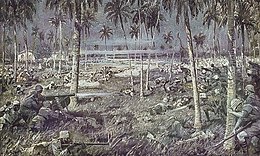
The defeat of Dulebia in Melasia and the containment of its fleet in its colonial port in southern Yudong virtually ended all activity of Central Alliance nations in the region. Despite the presence of significant Dulebian naval forces in Yudong, the lack of friendly ports meant that no activity other than static defense could be performed. In order to divert coalition forces back into the region and allow Dulebian troops in Yudong to harrass supply lines, Central powers began negotiations with the government of Kenlong as early as late 1911. The Empire of Kenlong already had a long lasting conflict with Mascylla and even scored a victory following a bloody 17-year civil war in 1890. The Kenlongese Lạc dynasty signed a peace treaty with Mascylla following its victory in the civil war. After several months of negotiations and the promise to receive most of the Melasian archipelago after the war, Kenlong joined the Central Alliance in March 1911, declaring war on the Mascyllary empire and all of its dominions and invading the crown colony of Kinh No and the Melasian Federated States shortly thereafter. The colony of Kinh No, being just a trade port without strategic depth, found itself quickly overrun by Kenlongese troops and surrendered after only a 5-day siege. The opening of Kenlongese ports allowed Dulebian military ships in Yudong to once again start raiding operations in the region, but those were still limited due to the presence of significant Mascyllary naval forces in the region, and the ever growing popularity of convoys.

In the meantime, as an urgent measure to protect its dominion, Mascylla allowed the Melasian army to form its own command structure from native officers and start an organised defence of its home territory with the assistance of the Mascyllary Navy and the small colonial garrisons scattered across the Melasian Peninsula. Being better armed, trained and with fighting experience from the Melasian Uprising from the previous decade, the Melasian troops managed to push back the mostly peasant Kenlongese army relatively quickly. Simultaneously, the Mascyllary navy squadron that remained in the region after the fall of Dulebian Melasia bombarded the Kenlongese capital city of Phượng Hoàng several times throughout 1912. Melasian troops managed to connect the exclave of Kinh No and the port of Da Pha with the rest of the Melasian territory in June 1912, and reached the capital of Phượng Hoàng one month later, in late July 1912, besieging it. The siege would last until September 1912, when the defences of the capital were finally breached following a successful naval invasion of the port of the city, only to find out that the royal family was successfully evacuated to the city of Phong Xuan in central Kenlong. Following several months of bloody guerrilla warfare in the jungles of central Kenlong, the royal family was finally captured in February 1913, bringing the conflict in Kenlong to an end. The whole territory of the kingdom was occupied by the Federated Melasian States, and the state would also receive an Assembly of Nations mandate over the region on the Treaty of Lehpold in 1917, making Melasia the only colonial asset to receive such a mandate after the war.
Yudong
Following the defeat of Dulebia in Melasia, its Melasian squadron disengaged to Pavlovsk-Vostochny, the last remaining Dulebian colonial port in the Eastern hemisphere. The port was an important asset of the empire, and was well-equipped with both ammunition and coal, and had a repair facility for the Dulebian military ships. The squadron under Glazkov, which previously destroyed the Mascyllary colonial squadron in the Tarokan Sea, now received an order to stay in the city and protect it at all costs. At the same time Xiao Jinshan, the leader of which was aware of the Dulebian defeat in Melasia, decided to join the XX to recapture the valuable city of Pavlovsk. Yudong declared war on Dulebia on 16 March, 1912, and sent most of its fleet under Admiral Zhaolin, as well as an army to besiege the port. The fleet reached the city and intered the Bay of Dongdao on 20 March, 1912. The Yudongese fleet numbered 25 ships, almost dounble the size of the Dulebian expeditionary squadron of Glazkov. However, while Glazkov fielded several modern battleships and dreadnoughts on par with smaller gunboats and destroyers, the Yudongese fleet only had outdated ironclad ships which stood no chance against the Dulebian navy. Zhaolin attempted a surprise attack in the early morning of 22 March 1912, but was spotted by Dulebian balloon and lost the element of surprise, vital to his tactic. The Yudongese navy suffered a crushing defeat, during which 21 ships were lost to enemy action, and Admiral Zhaolin was forced to retreat. In the same time, the land siege of the Yudongese suffered a similar faith, with the army of General Chen Baitao failing its primary objective of capturing hill Baranova Sopka on the outskirts of the city, where a small Dulebian garrison was stationed. With the defeat of the Yudongese fleet, Dulebian ships used their superiority to shell Yudongese positions and support the Dulebian garrison on Baranova Sopka. The squadron of Glazkov also managed to secure a steady supply chain from Kenlong, which joined the war on the side of Dulebia and Cuthland one month earlier. Following the complete defeat of Yudong in the Battle of Dongdao, the city remained uncontested for the next 4 years, only surrendering to the Mascyllary navy in 1916 after the end of the war.
The defeat of the Yudongese navy was used by Glazkov. Following the Battle of Dongdao, the expeditionary squadron left the port bay and headed to Mascyllary Kenlong, where the ships of Glazkov supported their Kenlongese allies during the sieges of Dong Hoa and Da Pha. Two ships of the squadron, namely the destroyer Preobrazhenets and the dreadnought Neustrashimy were detached from Glazkov's fleet in late-1912, and sailed to the Caphtoran Ocean to hunt down allied merchant shipping. The rest of the fleet under Glazkov continued its limited operations in Kenlong and the Saba sea until early 1914. In Pamira, the Yudonese Imperial Navy had covnerted into Armala's arm in the eastern region, and the country led the numerous military campaigns against the Central Alliance in the region. When news of the revolution at home reached Dulebian fleets, Glazkov took the decision to station the ships back in the bay of Dongdao. Following the defeat of both Dulebia and Kenlong, the port started to experience supply shortages, ultimately leading to the beaching of the ships of the expeditionary squadron and their use as static defenses during the Second Siege of Pavlovsk-Vostochny. The city managed to withstand the Yudongese siege again, but was forced to capitulate when the Mascyllary High Seas Fleet entered the Bay of Dongdao in early 1916.
Alvinia
Caphtora
Dulebian cruiser hunters
Karsk sea
Aftermath
Peace treaties and geopolitical changes
Treaty of Lehpold
Main article: Treaty of Lehpold

References
See also
Notes
- a.^ Dulebian Empire from 1911 until 1914, and the Provisional Dulebian Government from 1914 until 1918. The Dulebian Federative Socialist Republic signed an instrument of surrender (Treaty of Ulich after their seizure of power on 15 February 1914; the White Movement would not recognize said peace treaty until their defeat in the Dulebian Civil War in 1918.)
- b.^ Prior to the Bakunin's Breakthrough in May 1913.






